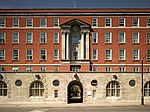Memorial to the Great Exhibition
1863 establishments in the United Kingdom1863 sculpturesGrade II listed monuments and memorialsGrade II listed statues in the City of WestminsterGreat Exhibition ... and 5 more
London stubsMonuments and memorials in LondonMonuments and memorials to Albert, Prince ConsortOutdoor sculptures in LondonUnited Kingdom sculpture stubs

The Memorial to the Great Exhibition is an outdoor monument commemorating the Great Exhibition (1851) and depicting Albert, Prince Consort, designed by Joseph Durham with modifications by Sydney Smirke and located south of Royal Albert Hall in London, United Kingdom. Originally installed in the Royal Horticultural Society gardens in 1863, it was relocated to its current site during 1891–1893 when the gardens were reconstructed and Prince Consort Road was created.
Excerpt from the Wikipedia article Memorial to the Great Exhibition (License: CC BY-SA 3.0, Authors, Images).Memorial to the Great Exhibition
Diamond Jubilee Steps, London Knightsbridge
Geographical coordinates (GPS) Address External links Nearby Places Show on map
Geographical coordinates (GPS)
| Latitude | Longitude |
|---|---|
| N 51.500342 ° | E -0.177292 ° |
Address
Memorial to the Great Exhibition
Diamond Jubilee Steps
SW7 2AP London, Knightsbridge
England, United Kingdom
Open on Google Maps








